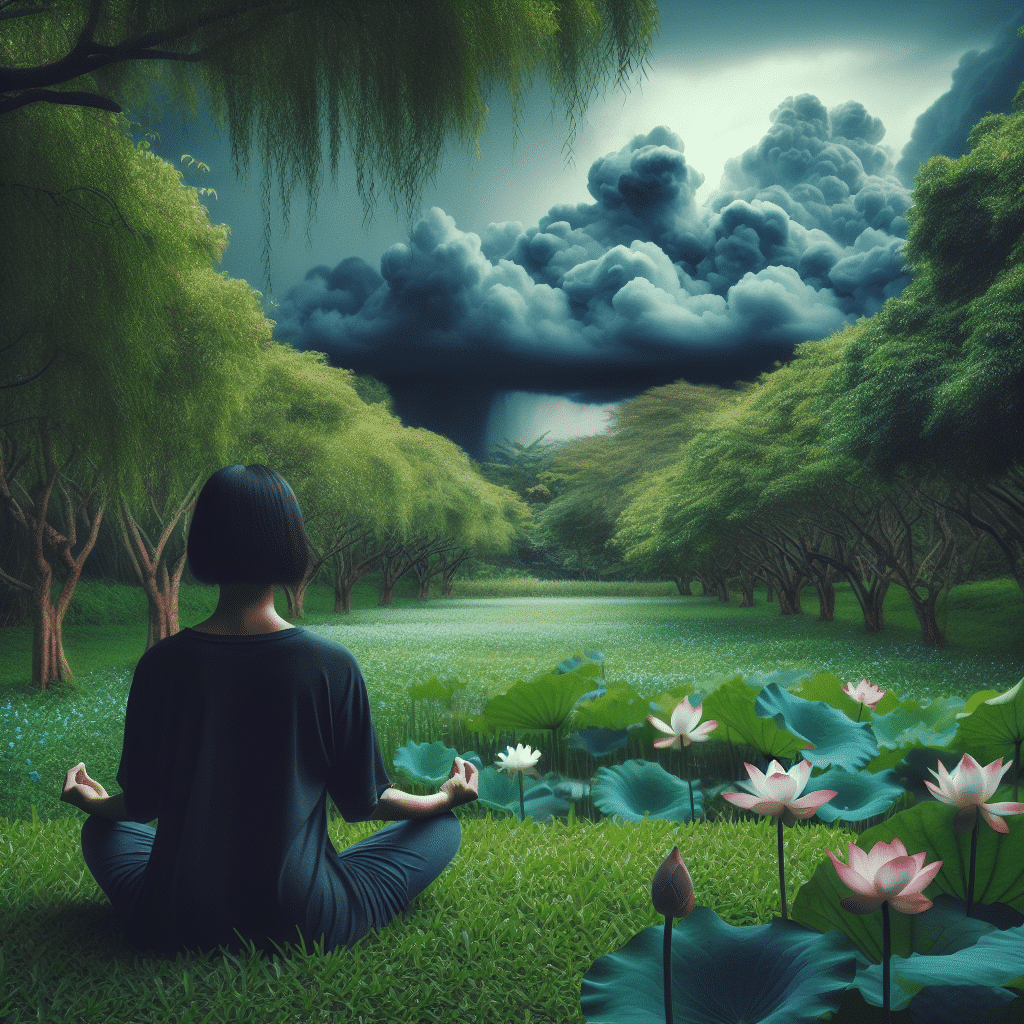
Finding inner peace is a beautiful and transformative journey that can bring immense joy and fulfillment to our lives. However, it’s important to recognize that this path is not without its challenges. In this blog post, we will explore the various challenges that can arise on our quest for inner peace and discover effective strategies to navigate through them. By understanding and addressing these obstacles, we can cultivate a sense of peace, harmony, and well-being that will positively impact every aspect of our lives. Join us as we explore the challenges on the path to inner peace and learn how to overcome them.
1. What is Inner Peace?
Inner peace is a state of harmony, tranquility, and contentment that is found within oneself. It is a deep sense of calmness and clarity that transcends external circumstances and allows individuals to navigate through life with serenity and grace. Inner peace is not the absence of challenges or difficulties; rather, it is the ability to maintain a sense of peace and calm in the midst of life’s ups and downs.
Inner peace involves a deep connection with one’s true self, where there is a sense of alignment between one’s thoughts, emotions, and actions. It is a state of being where there is acceptance, compassion, and forgiveness towards oneself and others. Inner peace goes beyond temporary happiness and material success; it is a profound sense of fulfillment and purpose that arises from being in tune with one’s values, beliefs, and authentic self.
When individuals experience inner peace, they often report feelings of clarity, joy, and connectedness. They have a sense of inner strength and resilience that allows them to face challenges with grace and maintain a positive outlook on life. Inner peace is not something that can be achieved overnight; rather, it is a lifelong journey of self-discovery, self-reflection, and personal growth.
There are different aspects of inner peace that individuals may strive to cultivate, such as emotional well-being, mental clarity, spiritual connectedness, and physical health. Each person’s journey to inner peace is unique, and the path may involve various practices such as mindfulness, meditation, self-reflection, gratitude, and self-care.
In the following sections, we will explore the challenges that can arise on the path to inner peace and discover effective strategies to overcome them. By understanding the nature of these challenges and developing the necessary skills and mindset, individuals can cultivate a lasting sense of inner peace and lead a more fulfilling and meaningful life.
2. Benefits of Inner Peace
Having inner peace brings about numerous benefits that positively impact every aspect of life. When individuals cultivate inner peace, they experience a profound sense of well-being, clarity, and resilience. Here are some key benefits of nurturing inner peace:
Mental and Emotional Well-being
Inner peace enhances mental and emotional well-being by reducing stress, anxiety, and negative emotions. It allows individuals to manage their thoughts and emotions in a healthy and balanced way, promoting mental clarity and emotional stability.
Improved Relationships
When individuals are at peace with themselves, it becomes easier for them to create harmonious and fulfilling relationships with others. Inner peace fosters compassion, empathy, and understanding, promoting healthier and deeper connections with loved ones and coworkers.
Enhanced Resilience
Inner peace helps individuals navigate through life’s challenges with resilience and grace. It strengthens their ability to bounce back from setbacks, adapt to change, and maintain a positive outlook even in difficult circumstances.
Increased Self-awareness
Developing inner peace encourages self-reflection and self-awareness. It enables individuals to understand their values, strengths, and weaknesses, which in turn helps them make conscious choices that align with their authentic selves.
Enhanced Creativity and Productivity
Inner peace fosters a state of flow and creative inspiration. It allows individuals to tap into their creativity, make clear decisions, and enhance their productivity by eliminating distractions and focusing on the present moment.
These are just a few of the many benefits of cultivating inner peace. As individuals work towards finding inner peace, they can experience a greater sense of fulfillment, purpose, and joy in their lives.

3. Challenges to Achieving Inner Peace
While inner peace brings many benefits, it is important to acknowledge that the journey towards attaining inner peace is not always easy. There are several challenges that individuals may face along the way. By understanding and addressing these challenges, individuals can better navigate the path towards inner peace.
External Distractions
Living in a fast-paced and hyperconnected world, individuals often face external distractions that can hinder their ability to find inner peace. The constant influx of information, noise, and digital devices can make it challenging to quiet the mind and find moments of stillness.
Stress and Pressure
Modern life is filled with numerous stressors and pressures, whether it be work-related deadlines, financial concerns, or personal responsibilities. These external pressures can create a sense of urgency and anxiety that make it difficult to cultivate inner peace.
Negative Thinking Patterns
Negative thinking patterns, such as self-doubt, self-criticism, and worry, can be significant barriers to inner peace. These thoughts can create a constant inner turmoil that prevents individuals from experiencing peace and contentment.
Past Trauma and Emotional Baggage
Unresolved past trauma and emotional baggage can also hinder the path to inner peace. Traumatic experiences or unresolved emotions can create internal conflicts, emotional distress, and a lack of inner harmony.
Attachment to Outcomes
Another challenge to achieving inner peace is the attachment to specific outcomes. When individuals become too attached to specific expectations or outcomes, they may experience disappointment, frustration, and a lack of acceptance, which can disrupt their inner peace.
It is important to recognize and address these challenges in order to cultivate inner peace. Through self-awareness, mindfulness practices, and adopting healthy coping strategies, individuals can work towards finding a sense of peace and calm amidst life’s challenges.
4. Strategies to Managing Challenges
While the challenges on the path to inner peace may seem daunting, there are strategies and practices that can help individuals overcome them and cultivate a sense of tranquility. By implementing these strategies, individuals can navigate the challenges and find a greater sense of peace within themselves.
Mindfulness and Meditation
Practicing mindfulness and meditation can be powerful tools for managing challenges and finding inner peace. These practices involve bringing attention to the present moment, observing thoughts and emotions without judgment, and cultivating a sense of acceptance and calm. Regular mindfulness and meditation practice can help individuals develop inner resilience and navigate the ups and downs of life more effectively.
Self-Care
Self-care is essential for maintaining inner peace. Taking care of one’s physical, emotional, and mental well-being is crucial for managing challenges and enhancing resilience. Engaging in activities that promote relaxation, such as exercise, spending time in nature, practicing hobbies, or journaling, can help individuals alleviate stress and cultivate a state of inner peace.
Emotional Regulation
Developing emotional regulation skills is key to managing challenges and maintaining inner peace. This involves recognizing and understanding one’s emotions, practicing self-compassion, and finding healthy ways to express and process emotions. Techniques such as deep breathing, journaling, and seeking support from trusted individuals can help in regulating emotions and finding a sense of equilibrium.
Change Mindset and Perspective
Shifting one’s mindset and perspective can have a profound impact on managing challenges and cultivating inner peace. This involves identifying and challenging negative thought patterns, cultivating optimism, and adopting a growth-oriented mindset. By reframing challenges as opportunities for growth and focusing on what can be controlled, individuals can navigate obstacles with greater ease and maintain inner peace.
Seeking Support
Seeking support from others is important on the journey to inner peace. Connecting with like-minded individuals, joining support groups, or seeking professional guidance can provide valuable insights, understanding, and encouragement. Sharing experiences and learning from others who have navigated similar challenges can provide a sense of validation and support in the pursuit of inner peace.
By implementing these strategies and practices, individuals can effectively manage the challenges that may arise on their path to inner peace and lead a more balanced and harmonious life.
5. Practicing Inner Peace
Practicing inner peace is an ongoing journey that requires commitment and regular effort. It involves incorporating daily habits and practices that cultivate a sense of tranquility and well-being. Here are some practices that can help individuals deepen their experience of inner peace:
Gratitude
Cultivating gratitude can significantly contribute to inner peace. Taking time each day to reflect on and appreciate the blessings in life can shift one’s focus from negativity to positivity. It helps cultivate a sense of contentment and helps individuals find peace in the present moment.
Self-Compassion
Show yourself compassion and kindness. Treat yourself with the same care and understanding that you would extend to a loved one. Recognize and accept your flaws and imperfections with compassion, understanding that you are only human. Embrace self-forgiveness and practice self-love as you navigate life’s challenges.
Disconnecting from Technology
Constant exposure to technology and digital distractions can disrupt inner peace. Make it a habit to disconnect from technology regularly and create pockets of peace throughout the day. Engage in activities that promote relaxation and self-reflection, such as reading, spending time in nature, or practicing mindfulness exercises.
Setting Boundaries
Establishing healthy boundaries in personal and professional relationships is crucial for safeguarding inner peace. Learn to say no to commitments that do not align with your values or priorities. Prioritize self-care, and create space for activities and relationships that bring you joy and peace.
Being Present
Mindfulness is a key practice in cultivating inner peace. Bring your attention to the present moment and engage fully in whatever you are doing. Practice deep breathing, listen actively to others, and savor the simple pleasures of life. By being fully present, you can experience peace and fulfillment in each moment.
Incorporating these practices into daily life can help individuals deepen their experience of inner peace and navigate the challenges that arise with grace and calmness.

Conclusion
In a world filled with constant distractions and challenges, cultivating inner peace is essential for our well-being and personal growth. It is a journey that requires self-awareness, commitment, and regular practice. By understanding the meaning of inner peace and the benefits it brings, we can actively seek ways to incorporate it into our lives.
Through practices such as gratitude, self-compassion, disconnecting from technology, setting boundaries, and being present, we can nurture and strengthen our inner peace. These practices help us navigate life’s ups and downs with grace and resilience, leading to a greater sense of harmony and fulfillment.
Remember, inner peace is a lifelong journey, and it’s okay to have setbacks. Each moment presents an opportunity to reconnect with ourselves and find peace within. Embrace the practice of self-reflection and make it a priority to cultivate inner peace in your daily life.
May you find solace and joy in embracing the path of inner peace, and may it guide you towards a life filled with serenity and purpose.






